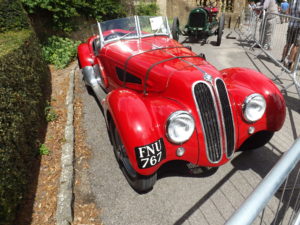Cookie Use Policy and Affiliate Link Info
This site uses cookies and continued use of the site acknowledges your acceptance of this policy. For details, visit the Classic Cars Online US About Page.
As an FYI: Affiliate links are used in several places around the site as part of the site’s advertising efforts, and while ads are what keeps our ‘doors open’, clicking the links does not in any way impact the cost of items you might purchase from advertisers.
A Brief History of BMW Motor Cars
By Tony Gee

In their early years BMW produced mainly aircraft engines, but also some motorcycle engines. In fact the BMW badge is supposed to resemble a spinning aircraft propeller. It wasn’t until 1928 when BMW bought a car factory at Eisenach/Thuringia that BMW began producing cars. Along with the factory they bought the licence to produce a small car called the Dixi. The first cars produced by BMW at the plant were badged BMW Dixi, but the word Dixi was soon dropped. They introduced a new model called the BMW 3/15 DA-2 and the success of this car enabled them to survive the great depression.

BMW’s involvement in aircraft engine production during WWII led to a 3 year ban on production at the end of the war. It wasn’t until 1949 that they were able to return to production which they did with the 250cc R24 motorcycle.

Also during the 1950s BMW bought the design and manufacturing rights to the Isetta which was to become one of the most successful microcars in the post WWII years. It was a time when cheap, short distance transportation was much needed and the 2-seater, with an economical 250cc engine, fit the requirements nicely. Manufacturing rights for the Isetta were sold to various production companies around the world and these included the British Railways works in Brighton, UK.


The 1990s, after 1994, saw BMW take ownership of the British Rover Group. This was not a successful venture and in 2000 BMW disposed of Rover.
Today’s ‘beemers’ have retained their highly prestigious reputation for quality and reliability.The company are taking steps to reduce the impact they and their motor cars have upon the environment so we can expect to see more innovative and exciting developments from the motor car company who have not only survived two world wars and a massive depression, but thrived.
Written by Laure
 Classic Cars Online US
Classic Cars Online US
- Embracing the Past and Future: Classic Car Trends Unveiled for 2024
- 10 Popular Classic Cars: Timeless Beauties on Wheels
- Put the Pedal to the Medal with New Classic Car Merchandise from Classic Cars Online US
- The Studebaker Company: A Journey from Wagons to Wheels
- Revolutionizing the Road: Unveiling the 1932 Studebaker President and Commander
- The Art Deco Revolution: How 1930s Automotive Design Embraced Luxury and Modernity
- Unveiling the Pontiac Chieftain: A Journey Through Its Iconic Generations
- The Iconic 1960 Chevy Bel Air: Evolution, Design, and Enduring Legacy
- The Timeless Elegance of the 1960 Chevy Bel Air: Exploring its Interior and Exterior Features
- The Enduring Charm of the Chevy Bel Air: A Classic Evolution
